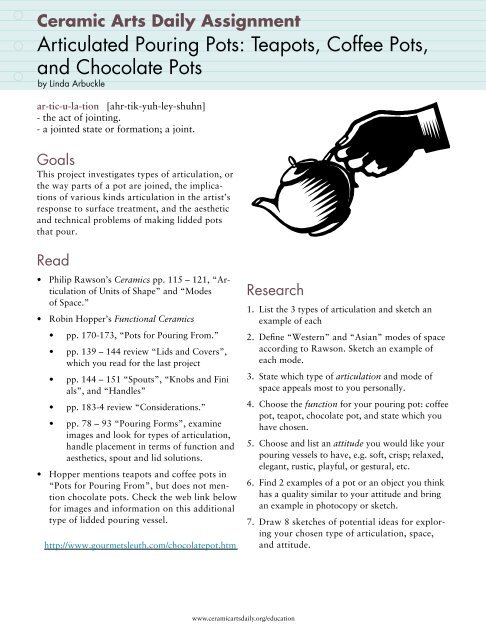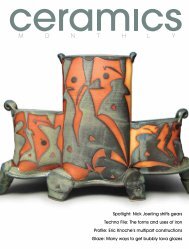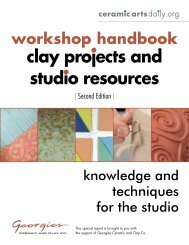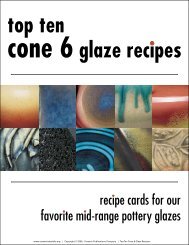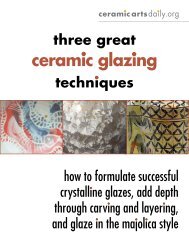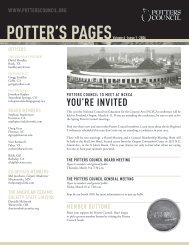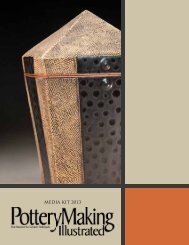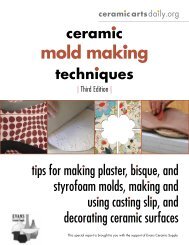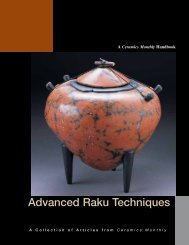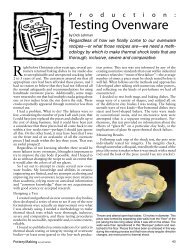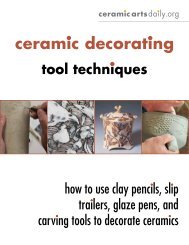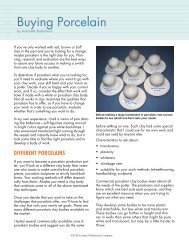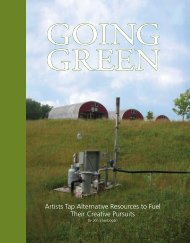Articulated Pouring Pots - Ceramic Arts Daily
Articulated Pouring Pots - Ceramic Arts Daily
Articulated Pouring Pots - Ceramic Arts Daily
Create successful ePaper yourself
Turn your PDF publications into a flip-book with our unique Google optimized e-Paper software.
<strong>Ceramic</strong> <strong>Arts</strong> <strong>Daily</strong> Assignment<br />
<strong>Articulated</strong> <strong>Pouring</strong> <strong>Pots</strong>: Teapots, Coffee <strong>Pots</strong>,<br />
and Chocolate <strong>Pots</strong><br />
by Linda Arbuckle<br />
ar-tic-u-la-tion [ahr-tik-yuh-ley-shuhn]<br />
- the act of jointing.<br />
- a jointed state or formation; a joint.<br />
Goals<br />
This project investigates types of articulation, or<br />
the way parts of a pot are joined, the implications<br />
of various kinds articulation in the artist’s<br />
response to surface treatment, and the aesthetic<br />
and technical problems of making lidded pots<br />
that pour.<br />
Read<br />
• Philip Rawson’s <strong>Ceramic</strong>s pp. 115 – 121, “Articulation<br />
of Units of Shape” and “Modes<br />
of Space.”<br />
• Robin Hopper’s Functional <strong>Ceramic</strong>s<br />
• pp. 170-173, “<strong>Pots</strong> for <strong>Pouring</strong> From.”<br />
• pp. 139 – 144 review “Lids and Covers”,<br />
which you read for the last project<br />
• pp. 144 – 151 “Spouts”, “Knobs and Fini<br />
als”, and “Handles”<br />
• pp. 183-4 review “Considerations.”<br />
• pp. 78 – 93 “<strong>Pouring</strong> Forms”, examine<br />
images and look for types of articulation,<br />
handle placement in terms of function and<br />
aesthetics, spout and lid solutions.<br />
• Hopper mentions teapots and coffee pots in<br />
“<strong>Pots</strong> for <strong>Pouring</strong> From”, but does not mention<br />
chocolate pots. Check the web link below<br />
for images and information on this additional<br />
type of lidded pouring vessel.<br />
http://www.gourmetsleuth.com/chocolatepot.htm<br />
Research<br />
www.ceramicartsdaily.org/education<br />
1. List the 3 types of articulation and sketch an<br />
example of each<br />
2. Define “Western” and “Asian” modes of space<br />
according to Rawson. Sketch an example of<br />
each mode.<br />
3. State which type of articulation and mode of<br />
space appeals most to you personally.<br />
4. Choose the function for your pouring pot: coffee<br />
pot, teapot, chocolate pot, and state which you<br />
have chosen.<br />
5. Choose and list an attitude you would like your<br />
pouring vessels to have, e.g. soft, crisp; relaxed,<br />
elegant, rustic, playful, or gestural, etc.<br />
6. Find 2 examples of a pot or an object you think<br />
has a quality similar to your attitude and bring<br />
an example in photocopy or sketch.<br />
7. Draw 8 sketches of potential ideas for exploring<br />
your chosen type of articulation, space,<br />
and attitude.
8. Review your sketches and choose the 2 ideas<br />
that you think have the most potential. Mark<br />
them as such.<br />
9. Bring photocopies of your sketches to class. We<br />
will look at your sketches and give feedback.<br />
Make<br />
1. Make 3 lidded pouring vessels that reflect your<br />
chosen articulation, mode of space, and function.<br />
2. Treat the surface in a way that responds to the<br />
form, the ideas reflected in you choice of spatial<br />
mode, and attitude.<br />
Evaluation<br />
1. Effective research, turned in on time<br />
2. Technical skill in making<br />
a. Even walls of appropriate thickness,<br />
effective foot treatment<br />
b. Lid that fits well<br />
c. Spout that pours well with<br />
minimal dripping<br />
d. Handle that is comfortable and<br />
balances well for lifting<br />
www.ceramicartsdaily.org/education<br />
e. Well-applied glaze<br />
3. Aesthetic skills<br />
a. Design decisions (e.g. proportion, color,<br />
surface, spout and handle placement and<br />
shape, knob, form, et al.) support choice<br />
of articulation, mode of space, and attitude<br />
and work together<br />
Resources<br />
• French, Neal The Potter’s Encyclopedia of Color,<br />
Form, and Decoration NK4235 .F53 1998<br />
• Lark Books 500 Teapots NK4695.T43 A14<br />
2002<br />
• Fournier, Robert L Illustrated Dictionary Of<br />
Pottery Form TT920 .F677 1986<br />
• Sandon, Henry Coffee pots and teapots for the<br />
collector. NK4695.C6 S26 1974<br />
• Li, Rongqing Yixing Tea Pot (video) from The Art<br />
of Chinese <strong>Ceramic</strong>s series NK4367.I35Y49 2000<br />
• Library or online search for teapots, coffee pots,<br />
chocolate pots will bring up many resources.<br />
Several of the library video series on throwing<br />
and pottery deal with teapots, spouts, pouring.<br />
Ask the librarian to help you locate them.


